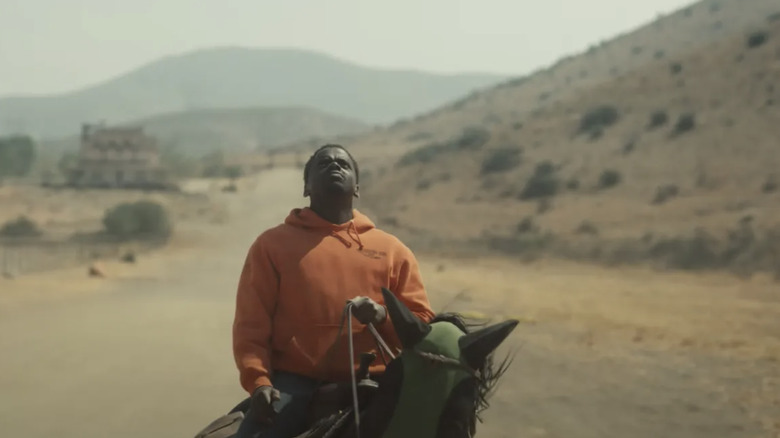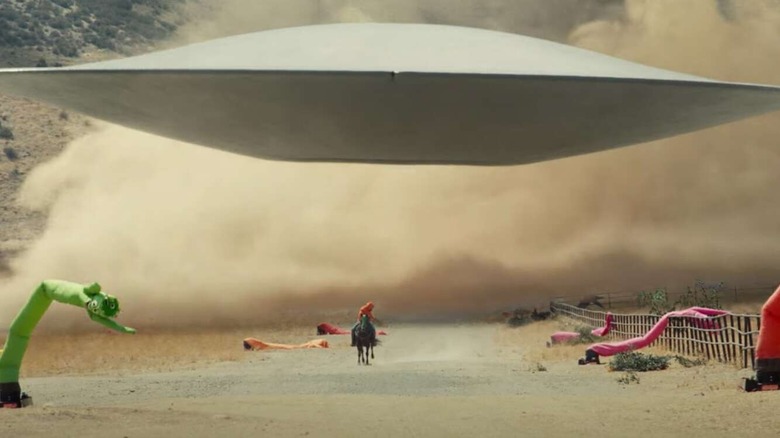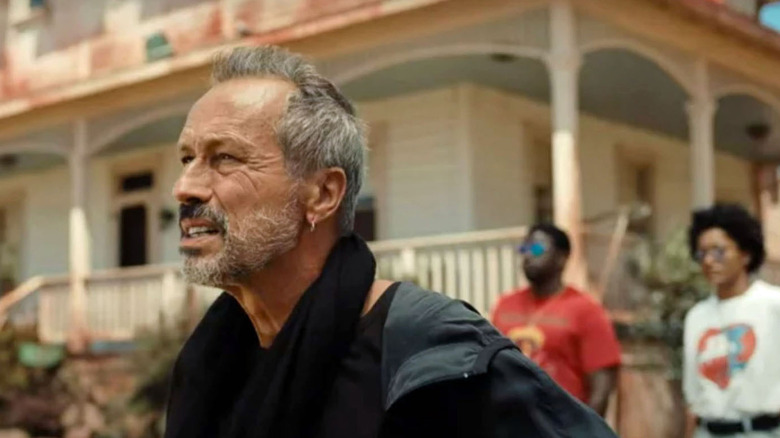How Nope Became The First Horror Film Shot With IMAX Cameras
One word that's been primarily associated with "Nope" since its release is spectacle. Jordan Peele's third outing as a director has been a spectacle in every sense of the word, with the film displaying a new side to Jordan Peele's filmmaking style. With a bigger budget and a bigger production comes a bigger-looking movie. Peele's movie budgets have gotten progressively bigger with each film he's made and, with it, new territories for the filmmaker to explore. One such unexplored territory for Peele is the IMAX film format, which was used for "Nope" to add to that feeling of a spectacle.
What's even more interesting is that "Nope" is the first horror film to be shot with IMAX cameras. Jordan Peele wanted his ambitions with "Nope" to match the film's scope, thus making the IMAX format less of a preference and more of a necessity. The flying saucer at the center of the film's story is one that needed to be captured in a format that would provide the enormous sense of scale, awe, and wonder that the movie is a parable about. For the film's production team and cinematographer, IMAX was a no-brainer for "Nope."
A visceral movie format
Speaking to Variety about the film's choice of format, Peele talked about cinematographer Hoyte Van Hoytema being his only choice, saying, "[Nope is] my most ambitious film to date. I knew Hoyte was the man." Hoytemea himself also told Variety that he believed IMAX was the best medium to tell this story. Peele's commitment to the format was rooted in the theatrical experience. He thought that the story of "Nope" and the tone he wanted to capture would need the IMAX format to communicate it effectively. Peele said,
"For me, IMAX is the most visceral of formats."
It wasn't a straightforward decision that went into the film's production. The IMAX format was used as creatively as possible, with Peele and Hoytema constantly reviewing their footage on IMAX screens and working towards a 1.43:1 aspect ratio that would provide 40% more pictures when viewed on an IMAX screen.
"Nope" features some incredible sequences that make the best use of IMAX, with thrilling chases and terrifying sequences that display the UFO in all its glory. More than that, the expanse of the film's setting required Hoytema to engineer a rig with digital infrared information that would darken the sky they were shooting in the daytime to look like night, with Peele telling IndieWire:
"It was hard, but we did it, and we're the first ones. And there's a reason that when you are in the night scenes, in my film, it feels different than any other film you've ever seen."
IMAX with a purpose
Not only is "Nope" the first horror film to utilize the IMAX format behind the camera, but the story of "Nope" also has the IMAX camera on display in the film. An analog IMAX camera is used in a pivotal scene in the third act of the film, acting as a part of the story on a technical level and a vital part of the film's plot. Jordan Peele is a filmmaker whose provocative nature of his stories, paired with the technical prowess a bigger budget can give him, help to create the spectacle he was reaching for when first conceiving this film.
"Nope" is the rare occasion that the IMAX format is used to its full potential. Aside from the occasional Tom Cruise event film, the IMAX aspect ratio has been used as a gimmick for the latest Marvel Studios movie without a true sense of purpose. "Nope" utilizes the IMAX format to show that the horror genre can experiment with different structures and scales in stories to reach new heights in storytelling. "Nope" may be the first horror film to utilize IMAX cameras, but I doubt it will be the last.


